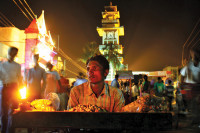Opinion
Land of the rising sun
Industrial and technological modernity and tradition seem to go beautifully hand in hand in Japan
Pramod Mishra
Japan came to my consciousness first in the seventies as Seiko watch that a few men proudly wore and a Panasonic short-wave radio that even few men owned in my village in eastern Nepal. Both of these solicited respect because they were both durable and well-made. The Bollywood song Gudia Japan ki le gayidil (“The Japanese doll stole my heart) or Mera Joota hai Japani, patloon Englishtani (My shoes are Japanese, pants English) came later when I went to rural India to study for high school. But Hiroshima and Nagasaki came earlier even in elementary school as words symbolising cosmic destruction that resembled Brahmashtra or the Shiva’s Tandav dance of the Hindu scriptures. Spending a week in Japan this past June on my way back from a family visit to Australia made me realise not only why Japan has become a coveted brand but also how seamlessly Japan has adopted industrial and technological modernity while preserving the fundamental core of its culture.
Striking my fancy
Two things struck me immediately to which I had not paid much attention before: Japanese politeness and the absence of greens in Japanese cuisine. Everywhere one went, people greeted each other by bowing down to which the other person would return immediately by doing the same along with exchanging words as whispers. Loudness was totally absent from conversation. Even when somebody seemed upset or frustrated (the latter more often when language didn’t work because very few Japanese knew English), there may not be a smile on the face but there would always be visible restraint in the face and bowing down. I asked a Croatian guide in Tokyo if the Japanese ever get angry. “After having lived for the last five years in Japan,” he said, “I know the reality but they would never yell and scream and use the four-letter word as we do when we get upset.”
Japanese meals (breakfast, lunch and dinner) revealed the elaborateness, the meticulousness and variety that manifests in other aspects of Japanese life: methodical cleanliness of the hotel rooms; the technology of its bathrooms (for example, the commode everywhere was electronically heated and internally equipped with aquatic cleaning system—an essential habit with Asians; and attention to details for creature comfort and convenience almost everywhere. Male and female hot baths were separate both in hotels and hot springs but no clothing was allowed in the water. While traveling in the Shinkansen (Bullet) trains from Tokyo to Kyoto and Kyoto to Hiroshima and back, one could see water-logged rice paddies in various stages of planting and growth right next to modern houses and factories and well-preserved green hills. Nature and industrialism seem to have co-existed harmoniously in Japan.
Japan remains a tried and tested popular brand in technology but the Japanese youth love the global brands in fashion. I looked everywhere for hats or T-Shirts with Japan-themed logo, but in vain. It seemed that the Japanese want to prove through quality and durability (made in Japan) rather than the symbolic logo that would explicitly sell Japan.
Absorbed in thoughts
I spent an unhurried day at the Hiroshima Peace Memorial Park, visiting its museum and monuments and walking around and resting in the leafy park. The city is bustling in commerce and urban lifestyle, making one forget if Hiroshima is Hiroshima or any other modern city. And the park itself is all green with trees and grass in the summer but the monuments and artifacts (photographs, texts, salvaged remains) hurl you into history and force you to confront and question development, progress and human achievement. It was a day of reflection and somber thoughts and questions for me.
The Hiroshima museum informs its visitors that the United States dropped the bombs fearing that if the US did not bomb Japan, Japan would go into Soviet embrace. It also said that the Japanese proposed surrender with an intact imperial throne but the US-led Allied Forces insisted on unconditional surrender and the Japanese refused.
For me, bigger questions that kept coming to my mind was—how was that the Meiji (“Enlightened”) restoration led to Japanese imperial ambitions, belligerence, cruelties in Manchuria (Nanjing massacre) and Korea and, above all, life and death pact with the Nazis and their hateful ideology? Finally, what was the source of such belligerence in such polite, soft-spoken people? Also, how was it that the Meiji Emperor whose real name was Mutsuhito, chose to adopt Meiji (enlightened) theme and name for himself and his reign at the age of sixteen, living as he had been in the eastern most country of the rising sun and his Samurais supported him?
I wanted to buy some peace memorabilia in Hiroshima but, surprisingly, the half a mile walk through the covered arcade lined with shops displayed branded merchandise, had none that would represent any aspect of Hiroshima—the historical experience. It was clear that by conscious effort, Hiroshima is madefor experience not for commodification to satisfy a tourist’s instant gratification.
The most pleasing aspect of my visit was Japan’s youth culture. Everywhere, but especially in Tokyo, one could see eateries and coffee shops packed with young people, especially young women. Throngs of young women in their teens and twenties sitting in pairs or groups chatting away over a meal or coffee or smoothie or shake. I wish I could understand Japanese and overhear samples of their conversations. I wondered if it was all about love, sex and fashion or something more.
Japan’s embrace of modernity seemed admirable. It has kept its language (hardly anybody speaks even English) and achieved everything in it; it has preserved its culture of gentleness and politeness and clothing while adopting those aspects that has made Japan the most coveted reliable modern brand. But my questions about Japan’s modern history since its Meiji Restoration leading up to World War II remained unanswered.




 21.12°C Kathmandu
21.12°C Kathmandu










